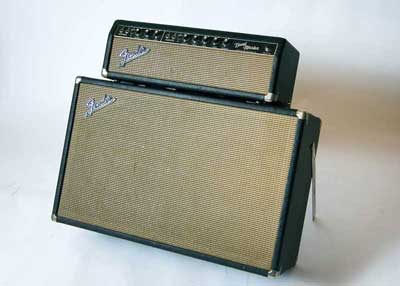

History
Photos
Schedule
Jim Mathis
Bob Kaat-Wohlert
Theresa Kaat- Wohlert
Wes Burrows
Articles by Jim Mathis
I Corinthians 13
Here's the Low Down
Let's Start a Band
Fourteen Generations
The Steel Guitar
Tubes vs Solid-State
"Ear" vs "Note"
FOR SALE It is time to sell our 1965 blackface Fender Bandmaster.
|
by Jim Mathis
Links:
Jim Mathis Music Blog
Mathis Photography
There is a lot of discussion about the relative merits of tubes verses solid state in musical instrument amplifiers. So I thought I would put in my two cents worth.
I attended electronics school between 1963 and 1966 to learn to repair electronic equipment. Back then most electronic gear contained tubes with not too much solid state. Since my interest was mainly guitar amps and sound systems, and those things were all tubes in the early sixties, that is what I remember. There has been a lot of advancement in solid-state technology in the past 40 years, not so much with tubes.
Basically a tube is a voltage amplifier; a small change in voltage at the grid produces a large change in voltage at the plate. A transistor is a current amplifier. A small change in current at the input produces a large change in current at the output. Since a speaker is a low-impedance device, typically 8 ohms, it needs a relative large amount of current at a relatively small voltage. That is why a transistor will drive a speaker directly but a tube needs an output transformer to convert the large voltage change to a large current change.
I played in a band full-time from 1966 to 1971. I played bass, was the road manager and was in charge of maintaining the equipment and, in some cases, building it. I started out using a Fender Showman. This was Fender’s biggest amp and remains one of the most powerful tube amps they ever made.
The Showman had 4 6L6 output tubes (parallel, push-pull.) They didn’t rate the power output in those days and there was no set standard for measuring power output. It probably put out about 85 watts, but I have heard the Showman called a 100 watt amp.
In about 1969, I bought a Kustom 200. It was a solid state amplifier rated at 200 watts, but not everybody used the same measurements, so power ratings can be dubious. The first thing I noticed is that I had to turn the Kustom up higher to get the same sound level. I was running the Fender around 3 or 4, but I had to set the Kustom to about 6 or 7. An actual side by side comparison showed that there wasn’t much difference other than the placement of the knob, and the Kustom was actually slightly louder. Fenders typically produce a lot of gain at the bottom of the control and not much happens past 5 or 6.
Putting this in automotive terms, the position of the accelerator is pretty insignificant in determining the performance of the car. There are just so many other things that go into determining performance.
Now I have four amplifiers ranging from a Fender Princeton that has been in my family for 50 years, to a state of the art solid state 300 watt Peavey Nashville 1000. Sky Blue often rehearses at Bob & Theresa’s. They have a number of amps both tube and solid state which I have used at various times. The Nashville 1000 at 300 watts, definitely has more usable clean power than, say, 100 watt tube amp.
Fender did not rate their amps as to power in 1954, but the Princeton probably puts out about 7 watts. It has amazing gain and is very loud in my music room, but when I use it with the band, it has to be miked. The power just isn’t there to keep up. It has one 6V6 tube which was never considered a powerhouse. Many console tube radios from the 1930’s used 6V6’s in the output.
An interesting side note: Leo Fender started as a radio repair shop. When he designed all the Fender tweed amps, the power supplies were too small, so they had a weird distortion when pushed hard because they “powered-out” when the strings were hit and then quickly recovered. Later when the CBS engineers took over, they “fixed” this “problem.” That is why early Fender amps are so highly valued.
Concerning the phenomenon where solid-state amps seem to be rated higher than tube amps for the same output. First, power ratings can be very misleading. For example, you have to double the power to get a 3 decibel increase in sound. Say if 5 watts would give a sound level of 60 db, it would take 10 watts to produce 63 db, 20 watts for 66 db, 40 watts for 69 db, 80 watts for 72, 160 watts for 75, 320 watts for 78 db, etc. So 1,000+ watt amps used at concerts are not at all overkill. The same is true with cars, if a 100 hp car will do 100 mph, a 500 hp will not do 500 mph – maybe 140.
Also, the methods used to determine power output are a little suspect, not unlike automobile engines were before 1971. A close read of the specs of a 1000 watt amplifier might reveal that it really puts out only 250 watts into an 8 ohm speaker. That 1000 watts was at 2 ohms, or unloaded, or whatever.
Tube amps are often driven at maximum output or even pushed over that to achieve a pleasant distortion. An overdriven solid-state amp does not work as well, so they are usually designed to be used well under maximum output. Distortion can be added though either on board or external effects. Obviously this is not quite the same sound as an overdriven tube. That is why some people are willing to pay a premium for tube amplifiers that use 50 year old technology.
In applications where clean sound and ultimate reliability are a concern, solid-state is the way to go. These situations would be sound reinforcement (PA’s), bass, steel guitar, jazz guitar, keyboards, electronic drums, etc.
In conclusion, tube amps are cool. I grew up with them and know how they work. They have a different sound, especially when pushed hard. Transistors are more practical, more reliable, and can produce huge amounts of power with relative little weight or money. There is clearly a place for both in today’s musical world.
